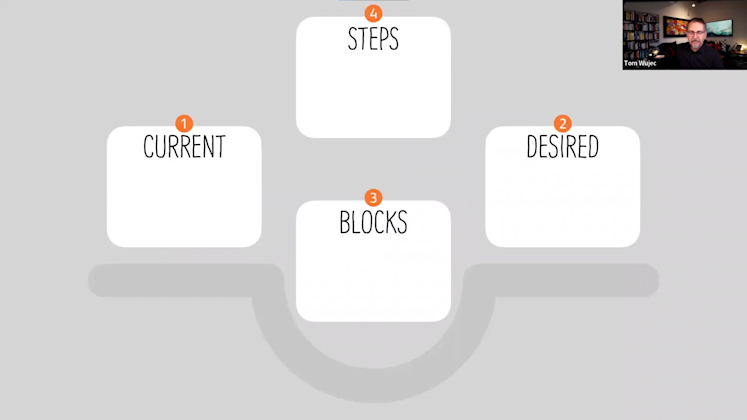Meet Tom Wujec, the creator of Wicked Problem Solving
Wicked Problem Solving is a collection of visual focused techniques to help individuals and teams crack open problems to lead to better aspirations and generate breakthroughs.
These methods are used by the world's most creative teams at companies like Pixar, Nike, and BMW.
What’s the secret to their creativity? They show their ideas visually, lead with key questions, and they work together collaboratively.
What makes creative teams...creative? Hint: "Plays"
A play is a time bound course of action that brings together three fundamental activities.
Leading with a key question
Make ideas visible
Engage with clear tasks (active participation)
Here’s an example of a “Post-Up Play” you can do if you have a difficult question you’re trying to solve at work.
Start with any key question, for example, “What should we prioritize next?” Get all of your team's ideas into a shared space, like a whiteboard. Next, organize them by urgency and importance (an Eisenhower matrix).
Urgency: What do we have to do now? What can wait for later?
Importance: What is vital to your mission?
This act of making things visible allows you to see much more than just talking. In fact, it’s even faster than talking because in the course of writing things down together, you can see what matters most.

Leap Plays: figure out where you are and where you want to be
A “Leap Play” helps us figure out where we are and where we want to be.
To start, draw a gap on a whiteboard, like this.

The goal is to label what we currently have and what we desire.
Here are some leadership examples:
We want to grow our coaching capability
Improve strategic thinking
Then, with your desires, you can more clearly label where you are at currently. For example, you can rank how effective someone is at coaching in an “F to A” scale, and label it on both sides.
For example:
Strategic thinking
Current: C
Desired: B
Now we identify the blocks, the issues that are preventing the team from going from C to B.
There are two kinds of blocks: Front channel and back channel.
Front channels are more obvious, like physical blocks.
Back channel is less obvious, but still critical. For example, if you want to shift strategic planning from 5% of your time to 40%, that’s a big change.
So how do we manage that?
First, we need to support a lot to make the change smaller and easier.
Second, how much money, time, and effort does it cost? Does this take 20 hours a week? Or is there a step-by-step guide to help?
Third, how do you feel? Does this shift make you happy, frustrated, jealous? What's the underlying emotion of the change?
Fourth, is the change imposed or is it invited? How much push or pull? For example, pushing a string up an incline plane is hard to do, but pulling is much easier. How can you design your idea so that it’s better set up to succeed?

Emotion maps: open up creative team conversations
An emotion map opens conversation in ways that you just can’t get with anything else. Here’s how it works.
Have everyone in conversation join a Miro session.
Place an emotion map in the middle. (google it)

Agree on a topic the group wants to discuss. For example, “The direction of our product.”
Then have people place red voting dots on the emotions that they associate with the topic. Have them choose up to 3 emotions. Make sure to instruct them to make their choices first before they vote to avoid bias.
Give everyone 3 minutes to plot how they feel.
Once they’re done, you’ll have a snapshot of people's emotions.
Then, as the facilitator, go around the votes and ask “What is it about the topic that is causing you to feel this way?”
By giving people room to explain the mechanism underpinning and driving their emotions, it opens up new ideas that might have been missed otherwise.
Trust Play: how trusting is our team?
This play was discovered 25 years ago at Lucasfilms. They were talking about the dynamics of a highly effective team and the CTO said, “It’s about trust. The firm believe in the capabilities of our team members.”
If trust is high, you can make magic. If it’s low, things fall through.
Here’s the equation they used:
Trust = Capability, Character, and Caring. When these 3 C’s are high, trust is high.
Open Miro and build a graph like this:

Have everyone place a dot where they think the organization or team (whatever you’re discussing) is.
After plotting, ask them to create sticky notes on the board on how they can create trust, and put it next to the graph.

Then ask the question openly: Where are we now vs. where do we want to be?
This visual representation opens up the group and creates breakthroughs by getting to the core issue.
Want to learn more problem solving methods?
Then get our free learning path on Innential: Wicked Problem Solving.
You'll learn two more techniques, including system models and draw toast.
Take the interactive online course
Wicked Problem Solving is an interactive self-paced course and toolkit that provides detailed processes and examples on how to effectively solve problems.
https://www.wickedproblemsolver.com/
Get 15% off the course with the promo code: WPSINN15
